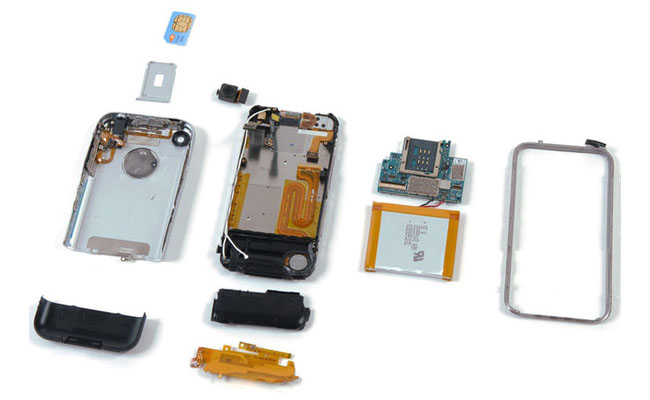The original iPhone was an outlier
When the iPhone was released in 2007, there was already quite a bit of ‘establishment’ from telephone makers. There was a wide range of smartphones: you had various Windows Mobile devices from HP, Acer, BenQ-Siemens, i-mate, QTEK and brands that we have long forgotten. For enthusiasts there was the Palm Treo. Sony-Ericsson had been making smartphones for years (including the characteristic light blue P800 from 2002) and the Nokia Communicator had quite a fan base. Those who did not want a smartphone bought a cheap Nokia. That's how simple the market was divided among the established parties.
It is therefore understandable that telephone makers from that time reacted skeptically to the rumors that Apple also wanted to make a telephone. What could Apple add to that as a newcomer? Miraculously, Apple managed to create a smartphone with the very first iPhone that wowed everyone and laid the foundation for Apple's huge market value today. It was technically not the most advanced smartphone. But Apple managed to strike the right chord with users.

In 2007 the market was dominated by Blackberry: you could easily type messages on the keyboard and push e-mail always kept you informed. Due to the slow data connections, mobile browsers weren't widely used and because the camera was pretty bad (or missing at all) you didn't use the smartphones of that time to take pictures either. However, apps such as calendar, address book and to-do lists were popular. There were already smartphones with a touchscreen, but they had to be operated with a pen.
What did Apple add as innovations? You can read that below!
#1 On-Screen Keyboard
Smartphones at the time had a hardware keyboard on which you could type texts nice and fast. An on-screen keyboard seemed unworkable in the eyes of users. But thanks to predictive text and autocorrect, Apple's on-screen keyboard turned out to be a hit.
#2 Capacitive screen with multi-touch
Swipe to unlock, it was something completely new. And zooming in and out on photos immediately gave users a wow effect. They were not used to this.
The plastic touchscreens of that era felt cheap and responded poorly to touch. The iPhone's screen was not only gigantic for the time, but was also super sharp and operated with your fingers. The starting point was not to make a phone that is easy to manufacture, but a phone that is intuitive and simple to use. Steve Jobs gave the designers priority over the engineers and that is exactly what made the iPhone a revolutionary device.


#3 Glass and aluminum
While manufacturers were used to making their smartphones out of plastic, Apple opted for something very otherwise: a glass screen and an aluminum housing, making the device look more luxurious. Also special: it looked minimalistic, because there was only one button below the screen.
#4 Safari browser
The mobile browser on the iPhone was the first you could actually use. It had to look like a desktop browser and web apps would allow countless uses. Steve Jobs didn't want an App Store, but came back to it a year later. Those web apps weren't that useful after all.
The very first smartphone was IBM's Simon, which appeared on the market in 1994. It had a touch screen and contained some simple apps such as a todo list, clock, email and a fax app. It cost $1100 and weighed around 500 grams. Operation was not very intuitive.

#5 No provider involvement
At the time the first iPhone appeared (especially in the US), the providers still had a firm hold on the market. Manufacturers had to make special phones with carrier logos and provide advertising apps, which users were not waiting for. Although Apple entered into an exclusive contract with AT&T, the power clearly lay with Apple. Providers have since faded further and further into the background and for many people are no more than a data pipe.
#6 Music and movies
Apple had already built a formidable reputation with the iPod as a music player. It was therefore the first device that Steve Jobs mentioned in his list: “An iPod, a phone, and an internet communicator”. The iPhone was more than a device for typing email, you could also enjoy music and entertainment. The iPhone piggybacked on the already existing success of the iPad.
The iPhone was also the first smartphone to make a breakthrough in mobile videos, by including the YouTube app as standard. Although the data connection was not that fast, you could stream the videos via WiFi.
#7 Internet in your pocket
Nowadays we are glued to our screens and you check Google or Wikipedia if you are looking for the answer to a burning question. We read news, check our social feeds and watch movies. Before the iPhone, most people used a desktop computer to browse the web. For people in emerging countries, the smartphone is the first and only device they use to use the internet. More people than ever have access to the internet thanks to smartphones.

A group photo of the original iPhone designers.
#8 Always a camera in your pocket
The original iPhone had a mediocre 2 megapixel camera on the back. Selfies had not yet been invented and video filming was not yet possible. Still, it was a huge leap forward compared to the 0.3 megapixel cameras you found in other smartphones. The iPhone quickly became the most popular camera on Flickr, the leading place to store your photos at the time.
Meanwhile, Apple has dropped out of the megapixel race and has been stuck at 12 megapixels for years. But we got more and more every year, such as telephoto and macro lenses, night photography and professional-looking movie features.


An image from the original iPhone commercial, showing how antique the phones of the time were.
#9 Sensors< br>The iPhone was the first smartphone with an accelerometer. This allowed the image to automatically rotate from portrait to landscape view. The image is therefore always correct, regardless of how you hold the iPhone.
Another innovation in the first iPhone was the proximity sensor, which ensures that the screen turns off during phone calls so that you cannot accidentally press buttons. And there was an ambient light sensor inside that ensures that the screen brightness is adjusted to your environment. It is still in today's iPhones.
#10 Visual Voicemail
For many people, the iPhone was the first introduction to Visual Voicemail, where you no longer have to listen to recorded messages in a fixed order. With Visual Voicemail, the voice messages appear as voice memos, which you can delete or save as desired.
There are, of course, other factors that have made the iPhone a success, such as the iOS operating system (iPhoneOS at the time).
Joanna Stern of the Wall Street Journal made a documentary about the very first iPhone and spoke with some of the Apple leaders involved:
On June 29, 2007 the iPhone was released to the world and so was Noah Schmick.
I traced the last 15 years of the iPhone alongside Noah’s life to see how it changed all of us—especially the younger generation.
Watch the full @wsj documentary at https://t.co/HP6HswpP7X pic.twitter.com/38dOTih5Ge
— Joanna Stern (@JoannaStern) June 28, 2022
The first iPhone didn't have this
In many ways, the first iPhone fell short compared to existing smartphones. And it was also very expensive. In retrospect, Apple appears to have made the right choices, so that the iPhone has become the dé smartphone that makes all other manufacturers cheat. The iPhone was not ahead in the following areas. This was missing from the very first iPhone:
- No 3G. There were already smartphones with 3G (UMTS), but with the first iPhone you had to rely on the much slower GPRS.
- Removable battery† This gave Apple the opportunity to build a much slimmer device, while interchangeable batteries were the norm at the time. If your battery went bad, you bought a new one.
- Memory card slot: Many smartphones back then had a memory card slot for external storage. Apple deliberately chose not to, so you can no longer expand your storage later. This is still the case today, although cloud storage has solved many of the drawbacks.
- Flash support† A conscious choice by Steve Jobs. Flash was theé standard for animations, but Apple didn't want to support it. Partly because it was too unsafe.
- App Store. Steve Jobs had high hopes for web apps, but developers and users alike didn't like it. Eventually apps came with an associated App Store.
- Cut and paste. Some basic features were not present on the first iPhone and were only added at a much later stage. “We didn't have enough time to get it right,” engineer Ken Kocienda later explained.
The original iPhone didn't have cut/copy/paste. Infamous! The quickest explanation is that I didn't have time to do it right. I had too much keyboard, autocorrection, and text system work to do. The design team didn't have time either. So we passed on the feature for 1.0. https://t.co/SLncIxohkk
— Ken Kocienda (@kocienda) June 19, 2022